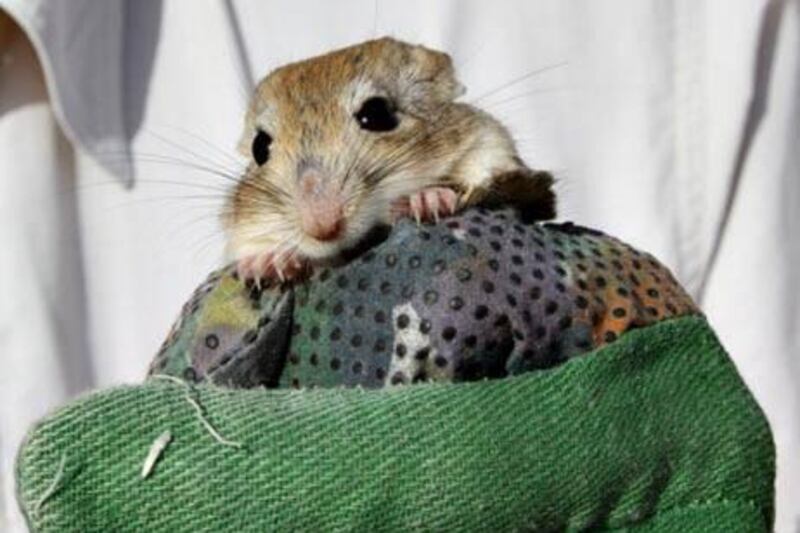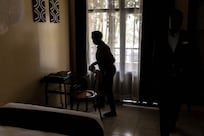DUBAI // A biologist carrying out research into the secret lives of rodents has recorded the first known visit of a rare rodent to the Dubai Desert Conservation Reserve.
The Sundevall's jird was caught in one of a number of traps left overnight as part of a year-long project by Stephen Bell, a conservationist at the reserve.
ANIMAL WELFARE
'Brutal torture' of cat shot 12 times A cat was shot 12 times with a pellet gun in its neck, jaw, pelvis, ankle and lungs, and is undergoing multiple surgeries. Read article
Man arrested with exotic baby animals in suitcase Emirati man arrested for animal smuggling after baby leopards, a monkey, gibbon and a bear were found in two suitcases. Read article
COMMENT: A brutal cat shooting that demands a local response This week's report of a tortured cat brings back memories of childhood efforts to help animals, efforts that still seem worthwhile today. Read article
The rodent is a member of a group of burrowing, long-tailed desert-dwelling animals related to the gerbil that are found between North Africa and China, but it is rarely seen in the UAE, and had not previously been spotted at the reserve.
So what is the secret to luring such a prized visitor? Apparently it is the mixture of peanut butter and birdseed - said to be irresistible to rodents - with which Mr Bell baits his traps.
After setting the traps, Mr Bell returns early the next morning to check whether any animals have taken the bait.
He records data such as their measurements and weight, then sets them free before the day becomes too hot.
The rodents are marked with a spot of indelible ink so they can be distinguished if they return.
"The Sundevall's jird had never been seen on this reserve before but we managed to catch one three nights in a row," said Mr Bell. "We've got good photographs of him so it was a good record.
"It was fantastic, it's always nice when you're putting in the long hours trapping and looking for things and you come across a species that hasn't been seen before.
"The main purpose of the survey is to see exactly what species we have here. So many people only think of the big things - camels, or oryx, or foxes, whatever it might be - and take for granted the small things. But rodents have a huge effect on vegetation populations through seed distribution, the disruption of soil, et cetera."
In fact, relatively little is known about the lives of rodents, principally because most researchers prefer to study species such as tigers, elephants and, in this region, oryx. As a result the study is likely to yield important new information about these secretive animals.
The reserve is able to support new species such as the jird as well as growing populations of other animals because the quality of the habitat has improved greatly. The area was previously home to farmed camels that decimated the vegetation, but they have been removed and fences keep them out. As a result the plants that provide food for the wildlife have recovered.
The other species that have been trapped by Mr Bell so far are the Cheesman's gerbil, the Baluchistan gerbil and the lesser Egyptian jerboa.
Another rodent, the Arabian jird, is known to live in the reserve but has not yet turned up during the survey.
Fifty sites across the reserve have been selected for the study, and Mr Bell lays the traps at each location for six nights in a row before moving on to the next one. So far he has surveyed 18 locations.
"During the summer we don't need any sort of bedding in the traps," added Mr Bell. "During the winter months, which we are approaching now, we'll put in sawdust or a bit of cotton wool so they can make a bit of a bed and keep warm."
Mr Bell's colleague Tamer Khafaga, a botanist from Egypt, will follow after him and investigate the effect that the rodents have on plants.
"I'm going to use the same sites to do the vegetation survey," said Mr Khafaga.
"I will mark the burrows and the vegetation around each one and see which plants the rodents prefer to build their burrows next to. I'll discover whether rodents affect the plants positively or negatively."
The 225-square-kilometre reserve near Al Ain Road covers nearly 5 per cent of Dubai's total land area and supports hundreds of species including rare mammals, reptiles and birds. Its best-known inhabitant is the Arabian oryx.






